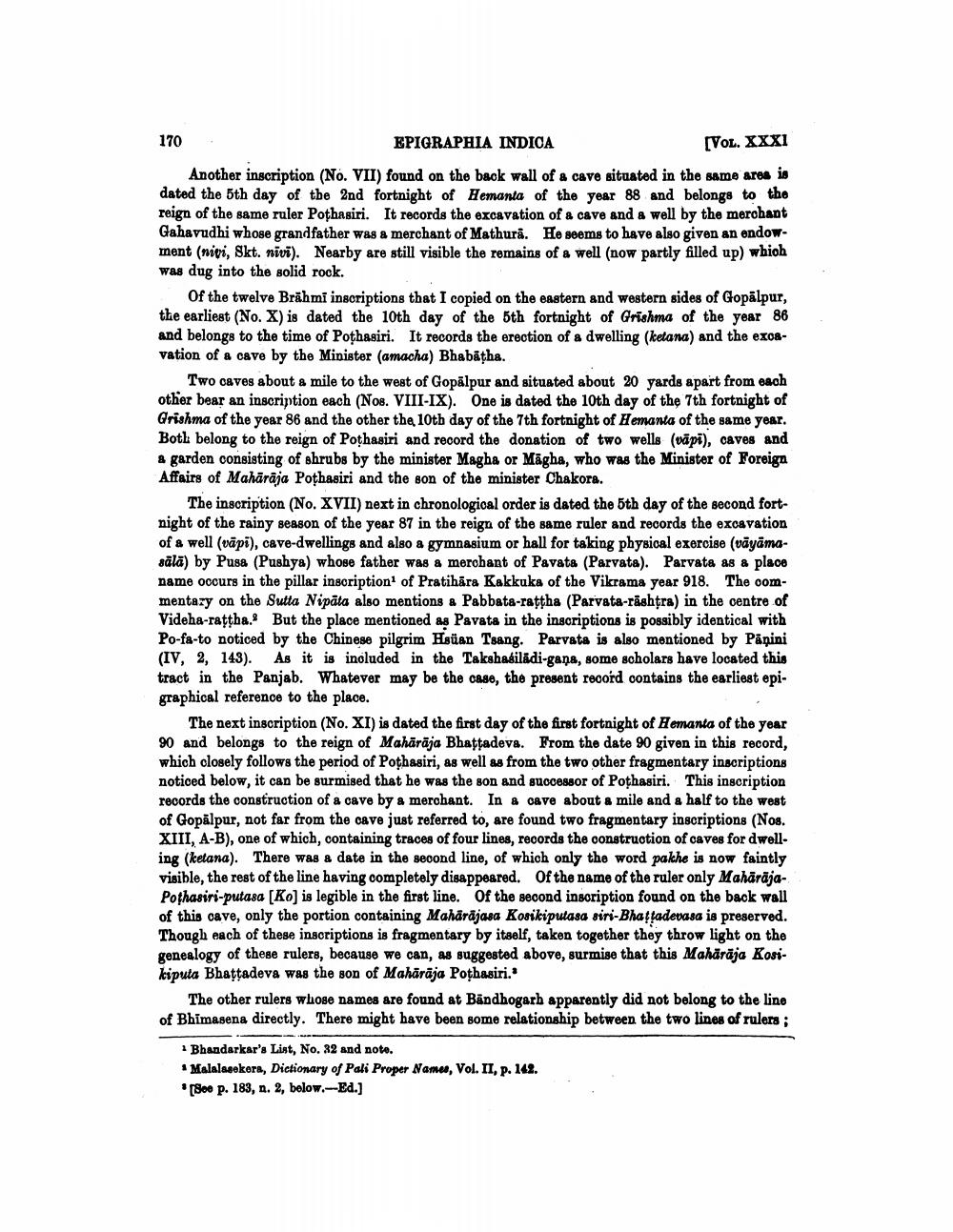________________
170
EPIGRAPHIA INDICA
[VOL. XXXI
Another inscription (No. VII) found on the back wall of a cave situated in the same area is dated the 5th day of the 2nd fortnight of Hemanta of the year 88 and belongs to the reign of the same ruler Pothasiri. It records the excavation of a cave and a well by the merchant Gahavudhi whose grandfather was a merchant of Mathura. He seems to have also given an endowment (nivi, Skt. nivi). Nearby are still visible the remains of a well (now partly filled up) which was dug into the solid rock.
Of the twelve Brahmi inscriptions that I copied on the eastern and western sides of Gopalpur, the earliest (No. X) is dated the 10th day of the 5th fortnight of Grishma of the year 86 and belongs to the time of Pothasiri. It records the erection of a dwelling (ketana) and the excavation of a cave by the Minister (amacha) Bhabatha.
Two caves about a mile to the west of Gopalpur and situated about 20 yards apart from each other bear an inscription each (Nos. VIII-IX). One is dated the 10th day of the 7th fortnight of Grishma of the year 86 and the other the 10th day of the 7th fortnight of Hemanta of the same year. Both belong to the reign of Pothasiri and record the donation of two wells (vāpi), caves and a garden consisting of shrubs by the minister Magha or Magha, who was the Minister of Foreign Affairs of Mahārāja Pothasiri and the son of the minister Chakora.
The inscription (No. XVII) next in chronological order is dated the 5th day of the second fortnight of the rainy season of the year 87 in the reign of the same ruler and records the excavation of a well (vapi), cave-dwellings and also a gymnasium or hall for taking physical exercise (vāyāmasāla) by Pusa (Pushya) whose father was a merchant of Pavata (Parvata). Parvata as a place name occurs in the pillar inscription of Pratihara Kakkuka of the Vikrama year 918. The commentary on the Sutta Nipata also mentions a Pabbata-raṭṭha (Parvata-rashtra) in the centre of Videha-raṭṭha. But the place mentioned as Pavata in the inscriptions is possibly identical with Po-fa-to noticed by the Chinese pilgrim Hsüan Tsang. Parvata is also mentioned by Panini (IV, 2, 143). As it is included in the Takshasiladi-gana, some scholars have located this tract in the Panjab. Whatever may be the case, the present record contains the earliest epigraphical reference to the place.
The next inscription (No. XI) is dated the first day of the first fortnight of Hemanta of the year 90 and belongs to the reign of Mahārāja Bhaṭṭadeva. From the date 90 given in this record, which closely follows the period of Pothasiri, as well as from the two other fragmentary inscriptions noticed below, it can be surmised that he was the son and successor of Pothasiri. This inscription records the construction of a cave by a merchant. In a cave about a mile and a half to the west of Gopalpur, not far from the cave just referred to, are found two fragmentary inscriptions (Nos. XIII, A-B), one of which, containing traces of four lines, records the construction of caves for dwelling (ketana). There was a date in the second line, of which only the word pakhe is now faintly visible, the rest of the line having completely disappeared. Of the name of the ruler only MahārājaPothasiri-putasa [Ko] is legible in the first line. Of the second inscription found on the back wall of this cave, only the portion containing Mahārājasa Kosikiputasa siri-Bhattadevasa is preserved. Though each of these inscriptions is fragmentary by itself, taken together they throw light on the genealogy of these rulers, because we can, as suggested above, surmise that this Mahārāja Kosikiputa Bhaṭṭadeva was the son of Mahārāja Poṭhasiri.'
The other rulers whose names are found at Bandhogarh apparently did not belong to the line of Bhimasena directly. There might have been some relationship between the two lines of rulers;
1 Bhandarkar's List, No. 32 and note.
Malalasekera, Dictionary of Pali Proper Names, Vol. II, p. 142. [See p. 183, n. 2, below.-Ed.]




